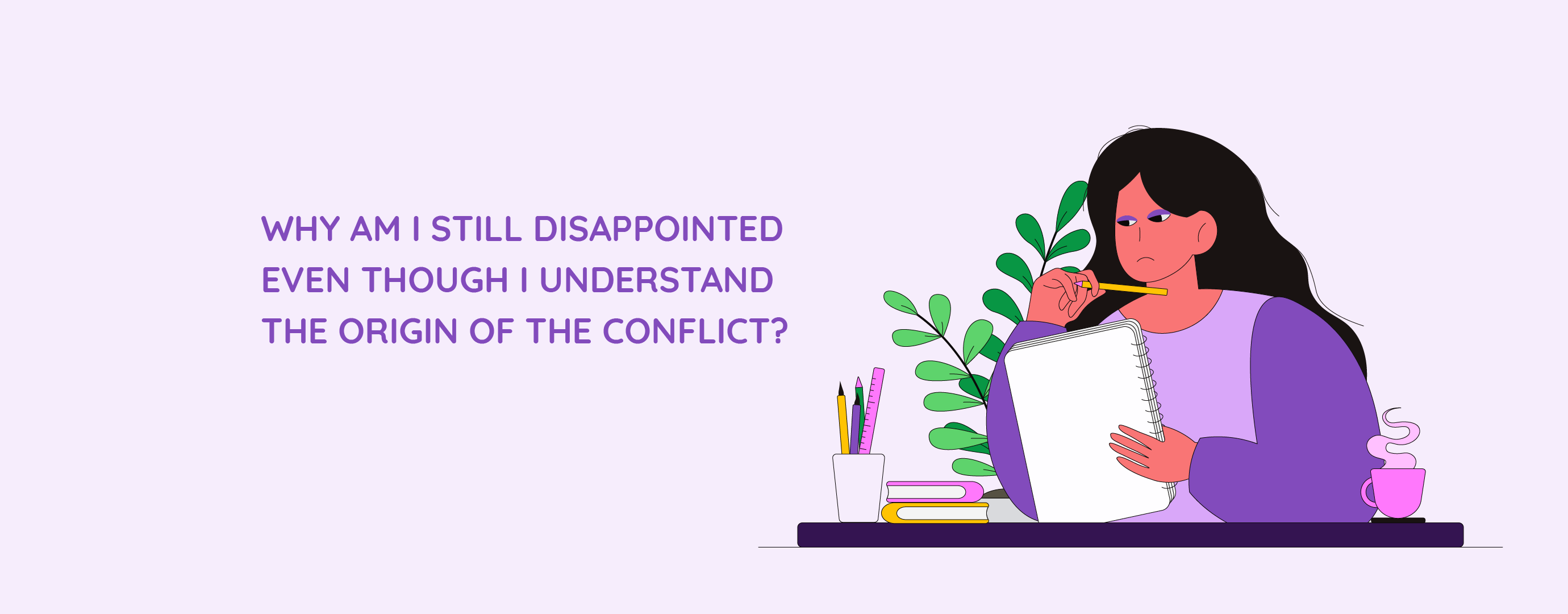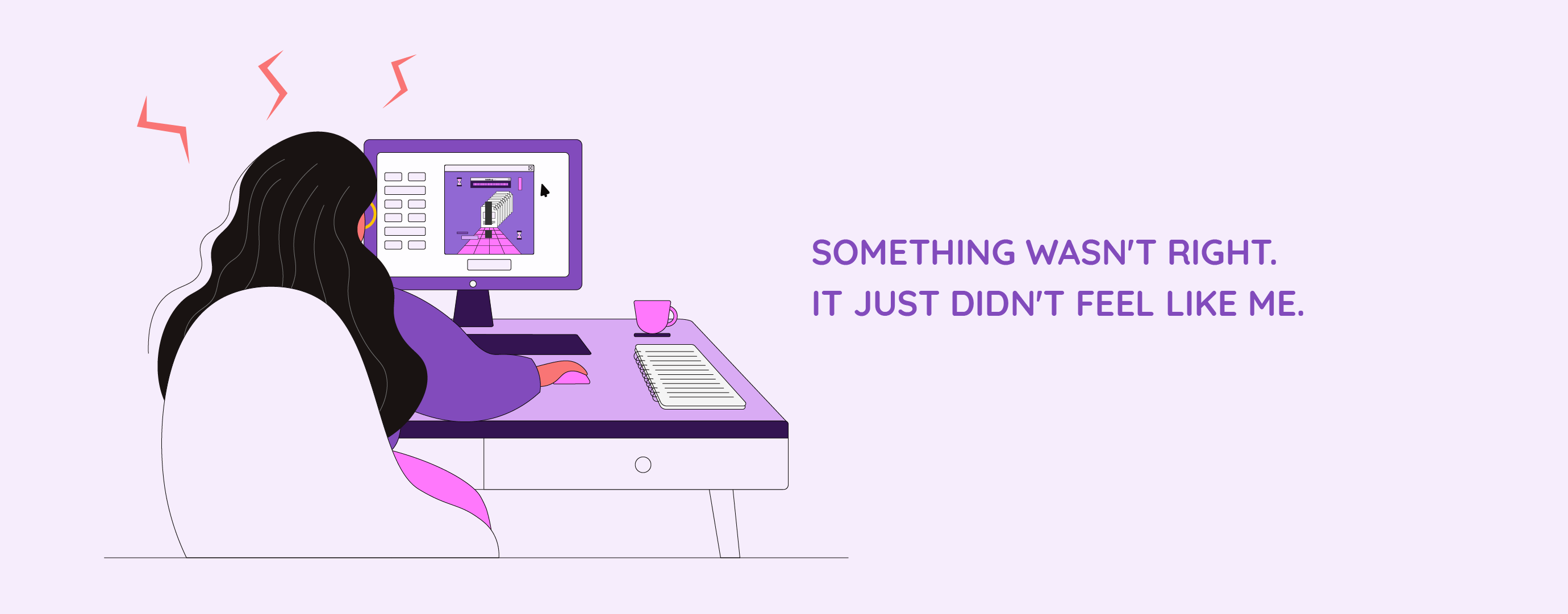Throughout my journey to becoming a Product Designer at BraveBits, I’ve faced countless choices. From deciding to pursue a career in design after graduating with an unrelated major to specializing in UI/UX after exploring various design roles, I’ve always been curious about my creative path. As my project list grew and I gained a better understanding of my strengths, questions began to arise: “Why do I constantly feel drained after exciting projects?”, “Why am I still disappointed even though I understand the origin of conflict between designers and stakeholders?”, “Why don’t I feel satisfied when a project is completed?”, and “Why am I hesitant to share my work with others?”

The first lesson in my design class wasn’t about design principles or tools, but rather self-awareness in the creative industry. I decided I wanted to be a “sustainable” creative. I chose design as my career, and to maintain long-term satisfaction, I wanted a job that would keep me inspired and allow me to maintain my independence despite external pressures. These questions surfaced when my subconscious realized I was going against my initial intentions.
From an Order-taker…
At the time, I was a UI/UX designer at an outsourcing company. My work primarily involved fulfilling specific design requests from clients or internal stakeholders without any context or overall product strategy. This is typical of outsourcing companies that focus on providing specific services to clients, prioritizing customer satisfaction and meeting deadlines over the product itself. While this approach isn’t wrong, it didn’t align with my desire for “sustainable” design and the opportunity to nurture real products. In other words, I wanted ownership of my work.
So, I decided to transition to being a Product Designer at a SaaS company, BraveBits.
to a Visionary.
My journey at BraveBits as a Product Designer was filled with opportunities to experiment and gain unique perspectives, especially on ownership. I want to share my experiences in this article and talk about how I shifted my mindset from service design to product design.
The Biggest Difference
At the outsourcing company, my products were design services, and my primary focus was on the client – the one paying for the service, not the end user. Most clients didn’t know exactly what they wanted, and the level of detail provided in the brief varied greatly. Projects were short-term with clear start and end dates. Moreover, I often juggled multiple projects, switching between clients and domains. While this broadened my experience, it limited my ability to execute and evaluate the value of my work. I spent a lot of time trying to figure out what the client really needed because the requirements had been filtered through BAs and Accounts. I also had no ownership of the product. After handing it over to the client, I couldn’t intervene, regardless of whether the product performed well or poorly.
I remember one time I was working on a website for a home services company. The client was quite unique and provided only a brief outlining basic requirements and a one-month deadline. I couldn’t really talk to them to figure out what they really wanted or who they were trying to reach. So, we finished the website, but it took forever because every time we showed it to them, they had a new idea. Of course, we missed the deadline. All that overtime and stress without getting to the heart of the problem made me realize something wasn’t right. At least, it didn’t feel like me.

When I moved to BraveBits, I was able to focus more on the long-term value of the product. I worked on a single product and had specific metrics to measure its performance. At BraveBits, Product Designers like me are responsible for the solutions we propose and their impact. This allowed me to witness and shape the product’s development over time.
Unlike service design projects, which have pretty flexible problem-solving processes that depend a lot on the client and project requirements, at BraveBits, I had to take the lead on creating solutions. In theory, when tackling a problem, I had to imagine going through these steps:

- Clearly define the problem and understand why we need a solution.
- Gather insights from users, businesses, the market, and analyze the product.
- Brainstorm ideas for solutions to the problem.
- Choose the best idea and turn it into a design.
- Write a spec – a document outlining the designer’s requirements for the structure and mechanisms, explaining the solution in detail.
- Hand over the completed solution to developers and support them in building the solution correctly.
- Ensure the final solution works as designed.
- Track metrics after the solution is launched so we can improve it.
In reality, I had to compare this process to my own abilities and the solution I chose, then figure out the best way for me to handle each task: what I should do myself and what I should ask for help with. Then I’d do it as efficiently as possible and keep an eye on the results to make improvements or changes if needed.
Being given full control (and responsibility) over my solutions helped me understand why I always felt so unsatisfied before, and why I was always disappointed when I had to compromise. It was because I knew I could come up with better solutions, but I didn’t have the power to do so. At BraveBits, I “own” my work, and I have to work directly with the project stakeholders to understand the real reasons behind the problem. Because I don’t have to go through the filter of Account Managers or Business Analysts, the information I get is exactly what I need, and there’s less chance of misunderstandings.
Developing a sense of ownership
Emotional Investment
For me, the transition from being a UI/UX Designer to a Product Designer wasn’t just about changing my job title. It was a shift in responsibility and how I felt about my work. I call it developing a sense of ownership over the product.
Being part of shaping the product’s direction and goals made me feel responsible and proud as a Product Designer. It’s not just about creating beautiful interfaces; I’m building something that can actually make a difference in people’s lives. It might sound a bit cliché, but it’s true. When you’re involved in discussions about the product’s future, working with other teams, and having a say in things beyond just “designing in Figma,” it makes you feel like you’re making a real contribution. As someone who works with user experiences every day, I know how powerful emotions can be in motivating people to go above and beyond, more so than just getting a “sign-off” from a client.
Challenges
Of course, it wasn’t easy to change my mindset overnight. After spending so much time working in an environment where everything depended on the client, I got pretty used to doing things a certain way, even though I knew I needed to change.
When I was doing outsourcing work, I didn’t have to write specs, and I didn’t need to explain to developers what a button did or where it led. I knew the limitations of the platform and knew which parts the developers wouldn’t customize. If there were any detailed explanations needed, the developers would refer to the SRS document created by the BA, and if there was a disagreement, the BA and developer would decide, and the designer’s opinion would come last.
This way of working made me stuck in a rut, even after I started working on products and had more control. When I first started as a product designer, I’d always look for safe, tried-and-true solutions. While that wasn’t necessarily a bad thing, it limited my ability to solve problems and my confidence in using my own judgment. Because I wasn’t used to my opinion being valued, I was hesitant to write specs and wasn’t sure if my solutions were right.
When I first started at BraveBits, I didn’t have a habit of really digging into the problem or asking myself if I was going deep enough or if I’d found the root cause. I was used to being given very specific problems to solve, and I didn’t have the freedom to ask “Why?” But now, working in an environment where I have more ownership, I find it the hardest part to figure out what the problem is and how to solve it.
I realized these issues when I looked back at my journey and got feedback from my manager, and I’ve been trying to improve every day. I’m actively seeking out challenging problems, trying new things, stepping outside of my comfort zone, and most importantly, learning more so I can be more confident in my decisions. I’m also asking “why” more often, even if it annoys people. I try to look at the bigger picture instead of just focusing on the details. I still have a lot to learn and areas to improve, but I love the learning process and seeing how much I’ve grown.
Conclusion

Working on products at BraveBits has really given me a great experience of ownership as a Product Designer. Somewhere along the way, I started feeling less confused because what I was doing no longer conflicted with my initial intentions – being empowered to solve new problems every day, keeping my creativity alive, being responsible for developing and protecting my independent thinking, and feeling confident in the face of the rapid changes in design and technology.
I hope this article provides a useful perspective for designers considering transitioning from service design to product design. If I had one piece of advice for anyone thinking about changing jobs, it would be to not be afraid to try new things. Owning a product isn’t just a responsibility; it’s also a chance to grow. While things might not always go as planned – because nothing ever is perfect – working as a Product Designer in a place where you have a lot of ownership is definitely a worthwhile experience.